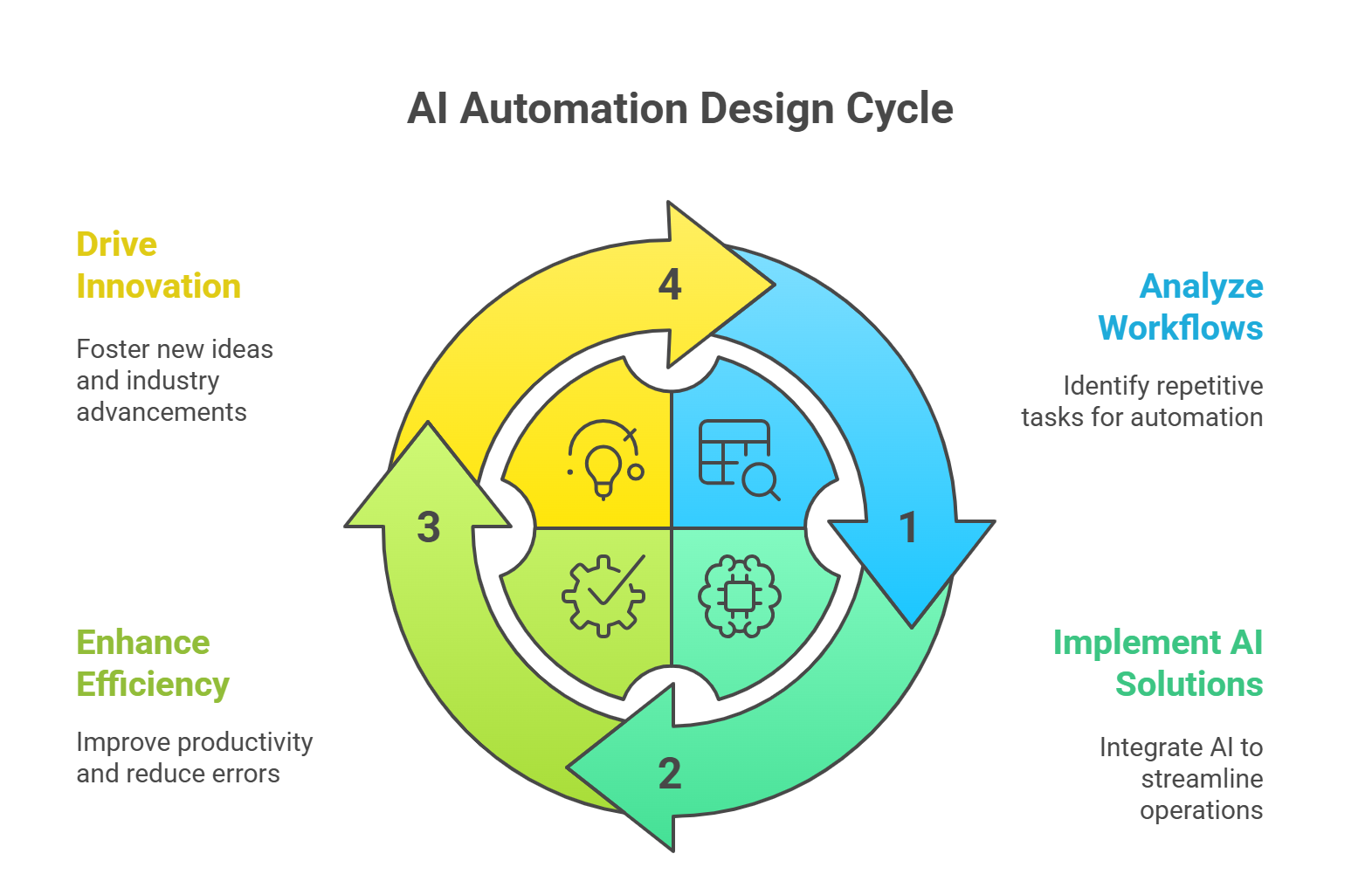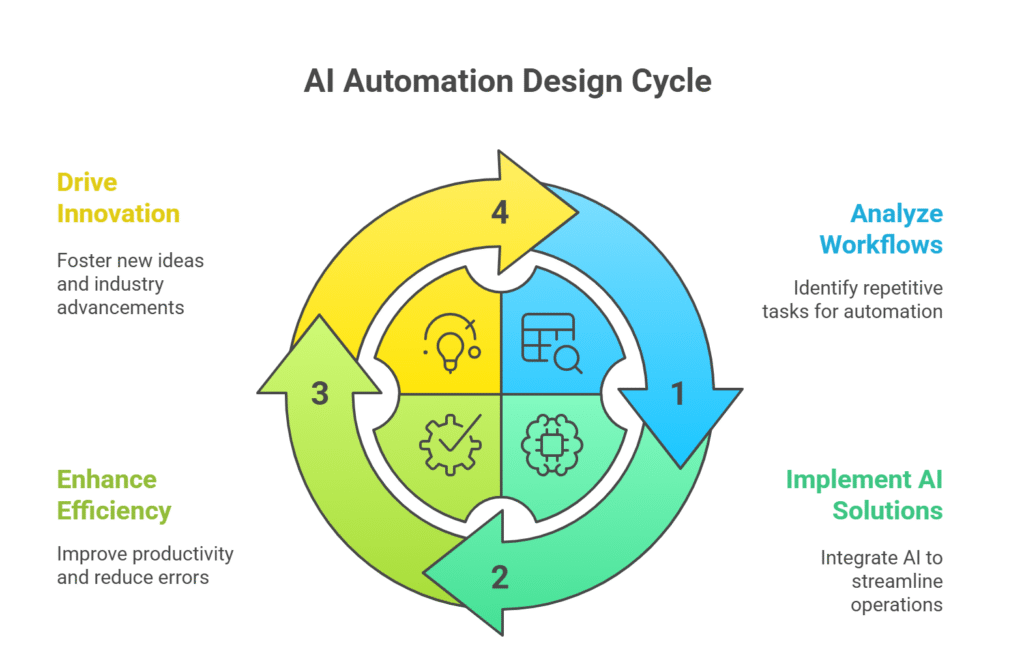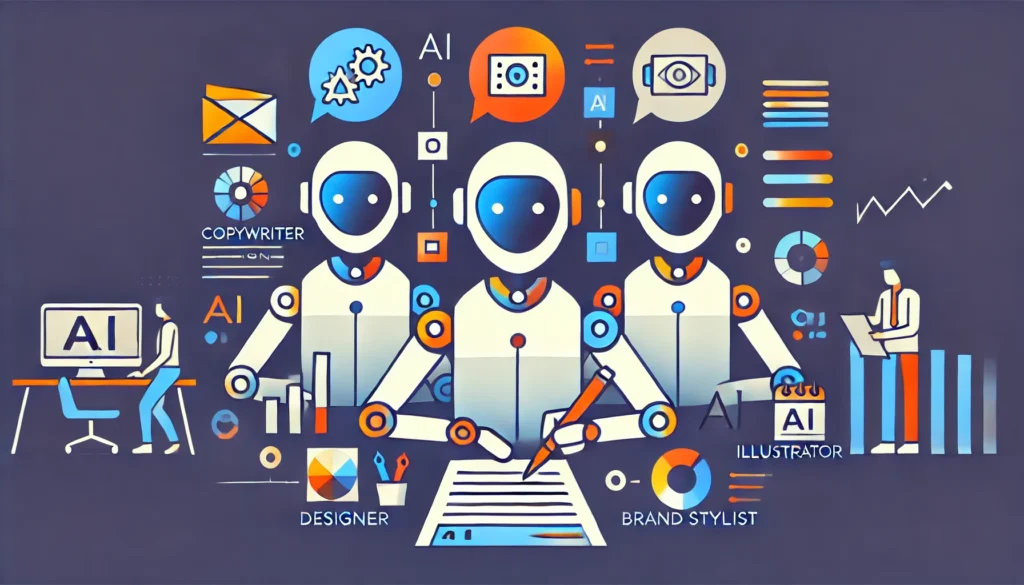
Designing AI automations
The business world is at a crossroads. For years, “automation” meant rigid, rule-based systems that could only handle the simplest tasks. But a new era is dawning—one powered by Artificial Intelligence (AI). This isn’t just another tech upgrade; it’s a fundamental shift that is reshaping how companies operate, strategize, and compete.
For leaders, understanding and harnessing AI automation is no longer optional. It’s the key to unlocking unprecedented efficiency, agility, and growth. This comprehensive guide will walk you through everything you need to know, from initial strategy and ethical considerations to choosing the right technology and navigating the future of work. Let’s build your blueprint for intelligent automation. 💡

Part I: The Strategic “Why” of AI Automation
Before diving into the “how,” it’s crucial to understand the “why.” The move from traditional, brittle automation to dynamic, intelligent systems is a paradigm shift. Understanding this shift and its immense value proposition is the first step toward transforming your enterprise.
Beyond Traditional Rules: A New Automation Paradigm
Traditional automation is like a train on a track—it’s effective as long as the path is straight and predictable. But what happens when the landscape changes? It grinds to a halt, requiring manual intervention.
AI automation, in contrast, is like an all-terrain vehicle. It uses sophisticated technologies to learn from data, recognize patterns, and adapt to new conditions on the fly. This allows it to handle the complex, unpredictable, and unstructured data that defines most real-world business processes.
This powerful new toolkit, often called Intelligent Process Automation (IPA), integrates several key technologies:
- 🤖 Robotic Process Automation (RPA): The “hands” of automation. Software bots perform high-volume, repetitive tasks like data entry and form filling.
- 🧠 Artificial Intelligence (AI) and Machine Learning (ML): The “brain” of automation. These self-learning systems analyze data, make complex decisions, and provide the cognitive power that traditional systems lack.
- 🗣️ Natural Language Processing (NLP): The “ears and mouth” of automation. NLP enables systems to understand, interpret, and generate human language, powering everything from chatbots to sentiment analysis.
- ✨ Generative AI: The “creative engine.” This frontier technology goes beyond analysis to create new, original content, such as human-like text, software code, and realistic images, expanding automation’s scope from transactional to creative tasks.
When combined, these technologies create a seamless workflow where the “hands” (RPA) can pass complex exceptions to the “brain” (AI) for resolution, automating end-to-end processes that were once exclusively human territory.
The Value Proposition: More Than Just Cost Savings
The business case for AI automation is compelling, delivering tangible benefits that fuel a virtuous cycle of growth and innovation.
Operational Excellence
- Increased Efficiency and Productivity: AI systems work faster and more accurately than humans on repetitive tasks. Automating inventory tracking or data analysis frees up employees for high-value strategic work, boosting overall productivity.
- Significant Cost Savings: Reducing manual labor is a primary driver of ROI. AI operates 24/7 and minimizes costly errors, with savings that can be reinvested into innovation.
- Enhanced Accuracy: AI eliminates human error in data-intensive fields like finance and compliance, ensuring higher reliability and preventing costly mistakes.
- Reduced Downtime: In manufacturing and logistics, AI-powered predictive maintenance analyzes equipment data to forecast failures before they happen, preventing costly operational halts.
Strategic Growth and Agility
- Effortless Scalability: AI allows businesses to handle massive growth in workloads without a proportional increase in staff, enabling rapid expansion.
- Superior Customer Experience: AI-powered chatbots provide 24/7 support, while AI analysis of customer data can anticipate needs and offer personalized solutions, dramatically improving satisfaction and loyalty.
- Data-Driven Decision-Making: AI’s greatest strategic benefit is its ability to analyze vast datasets and extract actionable insights. In a data-rich world, making faster, smarter decisions is a decisive competitive advantage.
This creates a powerful feedback loop: automation drives efficiency, which frees up capital and talent. This human and financial capital, augmented by AI insights, leads to better decisions and innovation. This drives revenue growth, which funds more advanced automation, starting the cycle anew at a higher level.
Part II: The Blueprint for Success: A Framework for AI Design
A successful AI initiative requires more than just technology; it demands a structured, strategic framework. This four-phase approach ensures your AI projects are purposeful, well-governed, and focused on delivering measurable value.

Phase 1: Strategic Alignment and Vision
This is the most critical phase. Your AI strategy must be woven into the core mission of your company. Start with a workshop involving executive leadership to answer the fundamental question: “How can AI act as a ‘mission multiplier’ for our business?”
Next, differentiate between two primary types of AI opportunities:
- Productivity Transformation: Using AI to make your internal teams and processes faster, cheaper, and more accurate. These are often “quick wins” that build momentum.
- Product/Service Transformation: Using AI to fundamentally enhance your core product, create new services, or even reinvent your business model. This is a more ambitious, long-term play.
A balanced portfolio addressing both categories delivers immediate returns and long-term competitive advantage.
Phase 2: Governance, Ethics, and Responsible AI
Before you write a single line of code, you must establish a robust governance and ethics framework. This isn’t red tape; it’s a critical enabler that mitigates legal, financial, and reputational risk. A proactive approach to ethics builds the organizational trust needed for widespread adoption.
Create a formal AI Ethics Blueprint by following these four steps:
- Define Purpose and Scope: Catalog all current and planned AI systems and map all relevant regulatory obligations (e.g., GDPR, HIPAA).
- Set Guiding Principles: Establish clear rules for AI usage. A great starting point is Microsoft’s six pillars of Responsible AI: Fairness, Reliability and Safety, Privacy and Security, Inclusiveness, Transparency, and Accountability.
- Establish Governance Structure: Create an AI review board or assign oversight responsibilities to ensure policies are followed.
- Plan Rollout and Training: Develop a comprehensive plan to train all affected employees on ethical principles and responsible AI usage.
The consequences of failure here are severe. Biased algorithms in healthcare have led to lower standards of care for minority groups, and flawed models have misdiagnosed diseases. These aren’t just ethical lapses; they are catastrophic failures. A strong governance framework is your primary defense.
Phase 3: Opportunity Identification and Prioritization
With a vision and guardrails in place, it’s time to find the right problems to solve.
First, conduct Process Discovery and Mapping. Work directly with frontline teams to create detailed maps of how work actually gets done, including undocumented workarounds. This “tribal knowledge” is invaluable.
Next, identify strong candidates for automation by looking for processes that are:
- Repetitive and rule-based
- Time-consuming
- Prone to human error
- Data-intensive
Finally, prioritize these opportunities using a structured framework:
- Impact vs. Effort Matrix: Plot projects on a 2×2 grid. Focus on the “High Impact, Low Effort” quadrant first. These are your “quick wins” that build momentum and secure buy-in.
- Return on Investment (ROI) Analysis: For larger projects, conduct a formal ROI analysis, quantifying both the costs and the expected financial benefits.
Phase 4: Building the Strategic Roadmap
Translate your prioritized list into a concrete, time-bound action plan. A “Now, Next, Later” framework is highly effective for organizing this roadmap and communicating it across the organization.
| Initiative Type | Now (3-6 Months) | Next (6-18 Months) | Later (18+ Months) |
| Everyday AI | e.g., Implement AI writing assistant for marketing | e.g., Deploy AI transcription for all meetings | e.g., Integrate AI into core CRM |
| Custom AI | e.g., Pilot a custom fraud detection model | e.g., Build an automated invoice processing system | e.g., Develop a proprietary underwriting model |
| Process/Policy Change | e.g., Redesign customer intake form | e.g., Standardize data reporting protocols | e.g., Centralize data governance function |
| Total Transformation | e.g., Launch an AI-driven personalized product line |
Export to Sheets
For each “Now” initiative, assign an owner, estimate the investment, and define the Key Performance Indicators (KPIs) you will use to measure success.
Part III: The Technology Stack: Architecting for Intelligence
With your strategy set, the focus shifts to the technology. Your choices here will determine the scalability, flexibility, and long-term success of your AI capabilities.
The Data Foundation: Garbage In, Garbage Out
High-quality data is the non-negotiable prerequisite for any AI system. The process of turning raw data into an AI-ready asset, known as data preparation, is often the most time-consuming but critical part of the entire lifecycle. This pipeline includes:
- Data Collection: Gathering diverse and representative data from all relevant sources.
- Data Cleaning: Handling missing values, removing outliers, and correcting inconsistencies.
- Data Transformation: Normalizing and encoding data so models can understand it.
- Data Labeling: For supervised learning, accurately tagging data with the correct output (e.g., labeling an email as “inquiry” or “complaint”).
- Data Validation: A final quality check to ensure the data’s integrity.
The Intelligence Layer: Choosing and Training Models
This is where the “magic” happens. The process involves selecting the right ML model (e.g., supervised, unsupervised), tuning its settings (hyperparameters), and training it on your prepared data. The choice of a machine learning framework is a major strategic decision.
| Framework | Key Features | Ideal User Profile |
| TensorFlow | Highly scalable, production-ready architecture. | Enterprise ML Engineers focused on stability and scale. |
| PyTorch | Python-native feel, flexible, great for research. | AI Researchers and Data Scientists on the cutting edge. |
| Keras | User-friendly, high-level API for rapid prototyping. | Beginners and teams needing to build and test models fast. |
| Scikit-Learn | Comprehensive library of classic ML algorithms. | Data Analysts and Scientists working on non-deep learning tasks. |
| AutoML | Automates the end-to-end ML pipeline. | Business Analysts and “Citizen Data Scientists.” |
Export to Sheets
The Platform Layer: Leveraging Cloud AI Services
For most enterprises, the cloud is the platform of choice for AI. Major providers offer mature ecosystems of AI services, and research shows 70% of companies get their AI capabilities from cloud-based software.
| Provider | Flagship Platform | Generative AI | Strengths |
| AWS | Amazon SageMaker | AWS Bedrock | Breadth of services, enterprise scalability. |
| Azure | Azure Machine Learning | Azure OpenAI Service | Seamless enterprise and hybrid integration. |
| GCP | Vertex AI | Generative AI Studio | Cutting-edge AI research and data analytics. |
Export to Sheets
The Development Approach: Custom Code vs. Low-Code/No-Code
A final architectural choice is how to build your solution. This involves a trade-off between speed and control.
- Low-Code/No-Code (LC/NC): Platforms that allow “citizen developers” to build solutions quickly with pre-built components. Ideal for simple workflows, internal tools, and rapid prototyping.
- Custom Development: Building a solution from scratch with a team of developers. Necessary for complex, mission-critical systems that provide a competitive advantage.
The right choice depends on the project. Use LC/NC for speed and simplicity; use custom development for power and differentiation.
Part IV: The Future of Work and Automation
The current wave of AI is just the beginning. To thrive, leaders must understand the trends shaping the workforce of tomorrow. The future isn’t about humans versus machines; it’s about humans managing increasingly autonomous machines.
Market Outlook and The Future of Jobs
Industry analysts like Gartner and Forrester predict a shift toward AI-led autonomous systems. The World Economic Forum’s (WEF) Future of Jobs Report 2023 quantifies this disruption, projecting that 23% of all jobs will change by 2027.
- Growing Roles: AI & Machine Learning Specialists, Business Intelligence Analysts, Information Security Analysts.
- Declining Roles: Data Entry Clerks, Administrative Secretaries, Bank Tellers.
The most profound shift is in skills. The WEF estimates that the core skills of 44% of all workers will be disrupted. The most in-demand skills are no longer task-specific but cognitive:
- Analytical Thinking
- Creative Thinking
This is followed by self-efficacy skills like resilience, agility, curiosity, and lifelong learning. This creates a massive and urgent need for workforce reskilling.
Final Recommendations for Enterprise Leaders
To navigate this new landscape and build a future-ready organization, follow these key principles:
- Embrace AI as a Strategic Transformation: Anchor every AI initiative in a clear business purpose. The goal is a virtuous cycle of efficiency, innovation, and growth.
- Govern Proactively, Innovate Confidently: Build your Responsible AI framework first. This de-risks projects, builds trust, and ultimately accelerates innovation.
- Invest in Data as a Core Asset: The quality of your AI will never exceed the quality of your data. Make data governance a C-level priority.
- Adopt a Balanced Portfolio Approach: Start with “quick wins” to build momentum, and balance the use of low-code tools with strategic investments in custom development.
- Reskill for the Future of Work Now: The biggest long-term barrier isn’t technology; it’s talent. Pivot your training strategy toward cultivating durable cognitive skills like analytical thinking, creative problem-solving, and AI literacy. Foster a culture of lifelong learning to create an organization that is ready to thrive in the age of intelligent automation.

